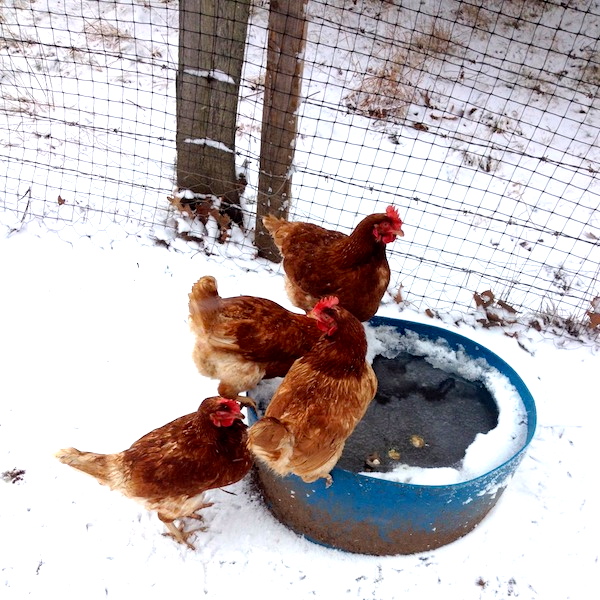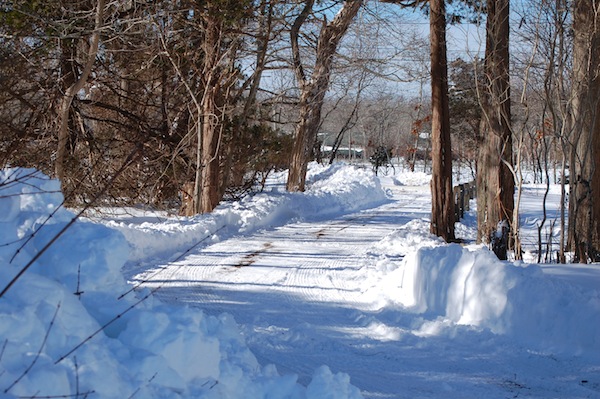 The answer to that question—“So what’s it really like to be a chicken farmer in a blizzard?”—is, “Not as bad as being a chicken farmer the day after a blizzard.”
The answer to that question—“So what’s it really like to be a chicken farmer in a blizzard?”—is, “Not as bad as being a chicken farmer the day after a blizzard.”
At first, I thought to answer the question this way: “Not as bad as being a cow farmer,” because cows have to be milked twice a day, no matter what, whereas chickens can be supplied with food and water, locked in their coops, and left for the duration of the storm (sort of). But then I realized that the cow barn is usually closer to the house than a whole bunch of chicken coops (seven coops, housing now only about 450 birds but will be 700 come March).
Unlike backyard chicken coops that tend to be located close to the house, our coops are way out in our back field because each one is integrated with a large fenced portion of the field so that all the chickens can have lots of room to roam around. (Photo below taken Monday, pre-storm.)
Every morning, Roy goes down and unlocks the small door on the front of each coop, allowing the chickens to go out. He then refills all of their feeders with heavy bags of grain he carries to the feeders from a central feed storage shed he built near the coops. Then he refills the large vessels of water out in the yard. This time of year, though, the hoses and the water vessels are mostly frozen, so we use axes and hammers to break holes in the ice for the chickens to access the water. (In bad storms, we’ve experimented with bringing water buckets inside the coop, but the hens tend to either knock them over or mess them up pretty quickly. So you can see that getting water to the chickens—who, like all livestock, must have regular water—is probably winter’s biggest challenge.)
During the morning and early afternoon, the hens (in normal weather) go in and out of the coop at their leisure to lay their eggs in nest boxes inside the coops. When evening comes, most of them also naturally gravitate back into the coop and get up on their roost bars. When Roy goes down to close and lock the doors (thus protecting the chickens from raccoons, feral cats, and other critters that might get in during the night), most of the chickens are inside, though during warmer weather and longer dusks it can take some encouraging. Inevitably, a few will jump into some of the trees in their yards and sleep there overnight.
People ask if the hens are warm inside the coop this time of year. Generally, yes. Their body heat, combined with the layer of poop and shavings that we leave on the coop floors during the winter to help insulate the coop (we layer on fresh shavings), raises the temperature. They tend to cluster together on their roosting bars, too. (Outside during a normal cold winter day, you’ll see hens happily hanging out in the yard because they have the ability to puff up their feathers, which traps air pockets and keeps them warmer.) However, since coops have to be ventilated, there are plenty of places where wind and stray snow can blow through in a blizzard. Wind will make the coops colder.
But obviously, your first decision in a blizzard is to forgo letting the chickens out of their coops in the morning. Keeping them inside roosting together is the only way to go.
The other daily task, of course, is egg collecting. Roy and I go down with buckets between 2:30 and 3 (when we’re sure they’re all finished laying) and collect the eggs out of the nest boxes. We enter the coops from a back door—a people door; the hens use the front door. You have to be sure to pull or hook the door shut once inside so that hens don’t push it open and go out the back. All of the big coops with outside latches have a wire you can pull from the inside to release the latch—without that, you’d risk the possibility of locking yourself inside the coop. (Which I did once in fact, do, in a smaller coop. But that’s another story.)
The hens tend to gather around your feet, peck at your pants and shoes and make a lot of clucking noises. It’s certainly not the worst task (cleaning the coops ranks at the top of that list by a mile), as long as you’ve got on your “chicken clothes” –thick boots, crummy jeans, thin work gloves, and a jacket you don’t care about since it’s going to get poop on it. (All of these clothes live on the mudroom floor.) And once you get the hang of it, it doesn’t take too long. But the buckets are heavy.
Carrying the buckets through thigh-high snowdrifts is a good deal more cumbersome.
And that has been the worst part of the blizzard. That, and an interminable amount of shoveling (interminable, as in not done yet) to get a path to the coops and to remove drifts. I, in fact, haven’t been all the way down to the coops since Monday. I’ve been halfway down, but Roy (and our nextdoor neighbor who’s been watching) tells me some of the drifts down there are six feet high. So you can imagine what it has been like getting the feed around, breaking the ice, and collecting the eggs for the last two days.
We lost one chicken (frozen, but it’s hard to tell if that was the cause of death—chickens sometimes just keel over), which all things considered, is not bad. And we lost probably about $100 in eggs because we were not able to collect eggs Tuesday afternoon during the worst of the storm, and by Wednesday morning, many were frozen and the hens in one coop had managed to knock over one row of nest boxes. We collected again yesterday afternoon.
We’ve now washed and packaged all the eggs from the last two days, and shoveled a path to the farm stand, which was completely snow-covered. Eggs are in the farm stand fridge, and we’re open for business.
It’s hard to say how much snow we got (maybe 18 to 20 inches?) because it blew constantly (occasional gusts over 60mph, but mostly in the 30 to 35 range I guess) and everything is essentially a drift. There are bare spots and sculpted towers. The inside of the farm stand—where we process everything in warmer weather—was covered in an inch of snow. And of course, the driveway was completely obliterated.
We don’t have a regular plow person, but Roy thought to call Keene’s Excavation right down the road from us, and a truck came right over—Hallelujah! We had been shoveling our way down the (very long) driveway in the meantime, and neither one of us was looking forward to doing the whole thing.
We’ll be shoveling more, and collecting eggs again later this afternoon. I guess the one thing all farmers buy into is the “daily” in daily chores.
In the end, it doesn’t matter if you’re a chicken farmer or a cow farmer or a sheep farmer—or even a strictly vegetable farmer—a blizzard is going to make your daily chores a lot more difficult, and/or it will likely cause some damage to your infrastructure. (Our hoop house is still standing, but we know of others who’ve had damage to barns and greenhouses. And only this morning I saw that the plastic cover over our arugula and spinach bed had lifted off, despite my doubled-up effort to weight it down.)
It sure looked beautiful out there (still does), but we aren’t too thrilled that another storm is on its way—tomorrow!
P.S. I did get down to the coops this afternoon to help Roy collect. Shoot-dang, it is DEEP out there! But I took the iPhone with me, and coming back, the light was beautiful on the snow, coming through the hoop house.














Your photos are beautiful but also allow folks to see where their food comes from. We raise sheep in Iowa, lambing in February. The weather can be dangerous, bothersome but holds beauty as you have shown us. Thank you for sharing this.
I love this blog..every time I read one of your blogs, I feel like I am right there with you and Roy..its hard work but it sure is worth it to us fresh egg loving clients..
Susie, I did wonder about wintering over laying hens. Isn’t their output much less than in summer? Is it light-dependent? Of course, you have so many chickens, maybe the decrease in egg-collecting is a good thing? We got about 24 inches here in Boston. Not as beautiful as the snow in the country.
Joannie–Thank you. All of this is because you had the kindness to think of us and go out of your way to introduce us to our future landlords. XO susie
Kathy M–Hens that are under a year old will lay straight through the winter–most people don’t realize that. We don’t light the coops, so the older hens do slow down quite a bit as December nears and pick back up again in early February. But the young ones (and we happen to have a lot this winter) keep on delivering. Hope you are staying warm–more weather coming our way–ugh!!
So sorry to be just responding to this Helen–spam problem now resolved and glad to be in touch with you!